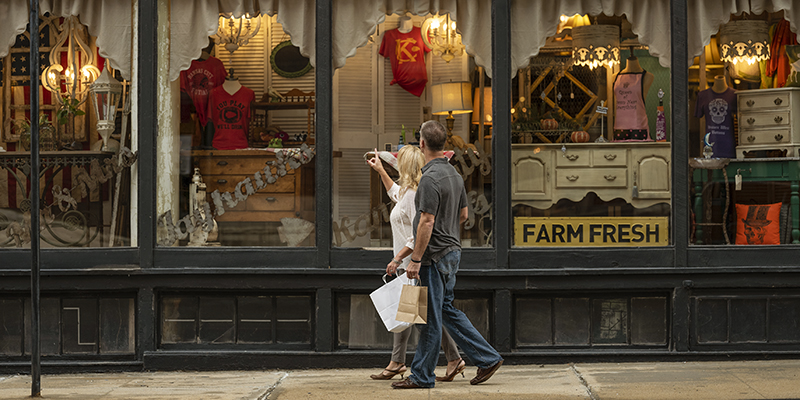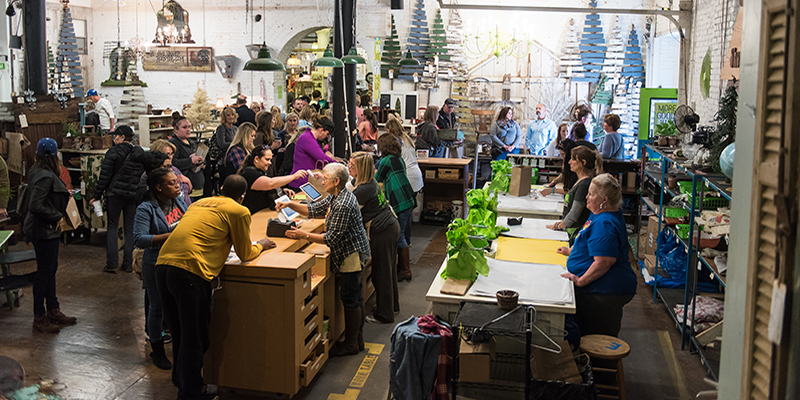BLOG
The Reinvention of Kansas City’s West Bottoms

By Kathryn Greene
Kansas City was once branded as a Cowtown. But what sounds like a contemptuous nickname from city dwellers is a historically accurate one, derived from the West Bottoms neighborhood.
For 120 years, the West Bottoms thrived as one of the defining parts of Kansas City’s economic and physical landscape with stockyards of cows, sheep, pigs and other livestock. The shuttering of the stockyards in the 1990s left the once-bustling area mostly stagnant but ripe for redevelopment.
Searching for an identity that isn’t rooted in agriculture, the West Bottoms is finding itself, leaning into its industrial past and quickly becoming one of Kansas City’s most exciting neighborhoods to watch.
Unique Background
With a central location and proximity to the railroad, the West Bottoms was prime real estate before the turn of the century. In 1871, the stockyards opened across 13 acres, housing thousands of animals. Proving successful, the stockyards began to sprawl out, eventually covering hundreds of acres and employing thousands of people, making Kansas City one of the biggest meatpackers in the Midwest.
At its peak toward the end of World War I, the stockyards processed a record-setting 55,000 animals in one day. Unfortunately, in 1951, the industry took a major hit when the Kaw River Flood wiped out the West Bottoms, causing nearly $1 billion in damages. Though recovery helped salvage the stockyards, things were never quite the same.
After several decades, slimming profit margins and increased competition made the stockyards no longer economically viable. On Thursday, Sept. 26, 1991, the area held its last livestock auction.
Changing Culture

Most of the West Bottoms lay dormant after the stockyards’ final auction, save for exceptions in longtime businesses like speakeasy The Ship and iconic Kansas City steakhouse The Golden Ox, which opened in 1949 in the historic Livestock Exchange Building.
Nearby Kemper Arena, which opened in 1974, served as a popular recreational facility—and as the one-time home of the Kansas City Kings basketball team and the American Royal. However, in 1985, the franchise moved to Sacramento, Calif., leaving the arena open only for special events throughout the year.
Looking to the Future

The early 2000s signaled a turning point for the West Bottoms. In 2007, antique mall Good Ju Ju opened in the former John Deere building, the logo of which can still be seen emblazoned on its frontage. Other antique shops (Nook and Cranny KC, Bella Patina) opened within a few years, attracting shoppers to spend weekends antiquing—the past-meets-present activity a symbolic beginning to the area’s revitalization.

In 2012, other businesses came to the district, including Amigoni Urban Winery in the Daily Drover Telegram Building, where the livestock industry’s namesake publication was produced. In 2014, bistro Voltaire opened, followed by Blip Roasters, Lucky Boys and Stockyards Brewing Company in 2015.
In order to avoid demolishing Kemper Arena, the city began accepting proposals in 2016 to repurpose it. After extensive renovations, Kemper Arena reopened in 2018 as Hy-Vee Arena, and in late 2018, craft cocktail bar The Campground opened, arguably the most modern concept in the West Bottoms to date, a harbinger of what is to come.

Today, the urban West Bottoms is a place to explore original architecture, try locally made coffee, beer or wine, get a late-night bite to eat or rediscover treasures from the past at one of many antique stores. Although many buildings in the West Bottoms remain unoccupied, they have transformed despite retaining their rustic facades; once reminders of lost prosperity, they now stand as symbols of the district’s remarkable potential.


